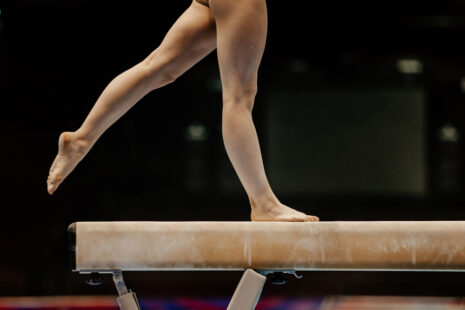Gymnastics, known for its high demands on flexibility, strength, and precision, unfortunately, comes with a risk of various injuries due to its dynamic and high-impact nature. Among the most common injuries faced by gymnasts, ankle sprains stand out due to the frequent jumps, landings, and flips involved in the sport. Understanding the causes, symptoms, and prevention strategies is crucial for gymnasts aiming to minimize their risk and ensure a long, healthy career in gymnastics.
Causes of Ankle Sprains in Gymnastics
- Improper Landings – Landing incorrectly from a jump or dismount can cause the foot to twist or roll, overstressing the ankle ligaments.
- Loss of Balance – Slips or missteps on the balance beam, floor, or during vaults can lead to awkward foot placements and sudden twists of the ankle.
- Overuse – Repetitive stress on the ankle without adequate rest and recovery can weaken the ligaments, making them more susceptible to sprains.
Symptoms of Ankle Sprains
- Pain – Sharp pain at the time of injury, which may worsen when putting weight on the affected foot.
- Swelling and Bruising – Significant swelling and bruising around the ankle are common signs of a sprain.
- Reduced Range of Motion – Difficulty moving the ankle, particularly when trying to walk, pivot, or jump.
Prevention Strategies
1. Strength Training
- Focus on Lower Leg Muscles – Strengthening exercises for the calf, ankle, and foot muscles can enhance stability and support for the ankle joint.
- Core and Hip Strength – A strong core and hips contribute to overall balance and stability, reducing the risk of falls and awkward landings.
2. Flexibility and Mobility Work
- Regular Stretching – Maintaining flexibility in the ankles and lower legs can help absorb the impact of jumps and landings more effectively.
- Joint Mobility – Exercises that improve the range of motion in the ankle can prevent stiffness and ensure smoother movements.
3. Proper Technique
- Skill Progression – Mastering gymnastics skills progressively, ensuring that the basics are solid before moving on to more complex maneuvers.
- Coach Supervision – Working closely with coaches to ensure that techniques, especially for jumps and landings, are executed correctly.
4. Use of Protective Gear
- Ankle Supports – Wearing ankle braces or supports during practice and competition can provide additional stability and prevent excessive twisting or rolling of the ankle.
5. Adequate Rest and Recovery
- Balanced Training Routines – Incorporating rest days into training schedules to allow for muscle and ligament recovery.
- Cross-Training – Engaging in low-impact activities such as swimming or cycling to maintain fitness while reducing stress on the ankles.
Ankle sprains are a common injury in gymnastics, but with the right preventative measures, their occurrence can be minimized. By focusing on strength, flexibility, proper technique, and the use of protective gear, gymnasts can protect themselves against ankle sprains and other related injuries. Always consult with a healthcare professional or sports medicine specialist for personalized advice, especially after experiencing an ankle sprain, to ensure a safe and effective return to gymnastics.




